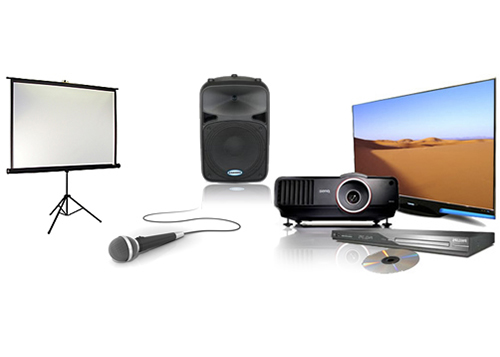The budgeting tips for audio visual charlotte nc services
Recognizing the Addition of Audio Visual Technology in Today's Educational Environments
The combination of audio-visual innovation in educational settings has actually changed the teaching and discovering process. Educators currently have access to devices that satisfy numerous learning designs, enhancing trainee engagement and cooperation. Nevertheless, the consolidation of these technologies offers both opportunities and difficulties. Understanding just how to effectively apply these devices is essential. What methods can educators utilize to optimize the benefits of audio-visual technology in their classrooms?
The Development of Audio-Visual Innovation in Education
As educational requirements evolved over the decades, audio-visual technology went through substantial transformations that reshaped the learning setting. Initially, tools such as film projectors and slide programs were the main means of incorporating visual components right into classrooms. These early innovations supplied educators with the capability to existing information dynamically, yet they were restricted in accessibility and interactivity.
With the advent of videotape recorder in the 1970s, classrooms started to incorporate documented lessons, broadening the extent of educational resources. The intro of individual computers in the 1980s additional revolutionized this landscape, permitting the production of multimedia presentations and interactive understanding experiences.
The increase of the web in the 1990s marked a zero hour, allowing real-time access to a wealth of audio-visual products. Today, digital tools such as interactive white boards and on the internet understanding platforms remain to improve the educational experience, promoting interaction and partnership amongst students.
Advantages of Audio-Visual Equipment for Diverse Learning Styles
Audio-visual tools play a crucial duty in accommodating diverse understanding designs by boosting aesthetic understanding and improving acoustic engagement. By integrating pictures, video clips, and noise, these innovations develop an even more inclusive educational environment. This multifaceted technique allows instructors to attend to the different preferences and demands of trainees properly.
Enhancing Visual Learning
Involvement in the knowing process is noticeably improved through the usage of audio-visual devices, dealing with different finding out styles. These tools, such as videos, infographics, and interactive presentations, supply aesthetic stimulations that assist comprehension and retention. Aesthetic students, specifically, take advantage of the incorporation of images and animations, which can streamline intricate ideas and enhance understanding. Furthermore, audio-visual sources can illustrate real-world applications, making finding out more relevant and interesting. By integrating shade, activity, and sound, instructors can develop a dynamic knowing atmosphere that captures pupils' attention and fosters deeper cognitive links. Eventually, the critical usage of audio-visual technology not just supports aesthetic understanding but also enhances the overall academic experience for varied students.
Improving Auditory Involvement
A significant advantage of integrating audio-visual tools in education is their ability to enhance auditory involvement among pupils. These devices, which encompass multimedia discussions, podcasts, and interactive audio elements, accommodate various learning designs, specifically benefiting auditory learners (audio visual charlotte nc). By incorporating noise and narrative, educators can produce immersive experiences that catch students' attention and strengthen comprehension. This involvement is important, as it cultivates a much deeper understanding of the product and advertises retention. In addition, audio-visual tools can help with collaborative understanding settings, motivating trainees to take part in discussions and share their understandings. Ultimately, the unification of audio-visual modern technology not just supports auditory engagement yet likewise enriches the total academic experience, making discovering more vibrant and effective for all students
Enhancing Engagement Via Interactive Learning

In addition, gamification components, such as tests and simulations, can improve inspiration and retention, making finding out more pleasurable and effective. These techniques not just boost cognitive involvement yet likewise satisfy diverse understanding styles, making certain that all students can get involved meaningfully. Because of this, interactive understanding settings cultivate a feeling of neighborhood and belonging, ultimately leading to boosted scholastic results. Via the assimilation of audio aesthetic modern technology, educators can transform typical class into vivid rooms where students prosper and actively shape their instructional journeys.
Bridging Concept and Technique With Multimedia Resources
Multimedia resources function as a crucial link between theoretical principles and functional application in instructional settings. By boosting involvement, helping with joint knowing experiences, and supporting varied learning designs, these tools create a much more comprehensive and dynamic discovering setting - audio visual charlotte nc. This strategy not just fosters much deeper understanding yet additionally prepares students for real-world obstacles

Enhancing Engagement With Multimedia
Involvement in academic setups greatly boosts when trainers include multimedia resources right into their training techniques. Using videos, podcasts, and interactive presentations improves the learning experience, allowing trainees to get in touch with the product on several degrees. Multimedia resources accommodate various discovering designs, offering visual, auditory, and kinesthetic stimulations that can hold students' interest better than conventional lecture approaches. Furthermore, these resources can simplify complicated principles, making them a lot more easily accessible and memorable. By integrating multimedia, educators can develop a dynamic class atmosphere that fosters curiosity and inspires learners. Eventually, the calculated use of audio-visual technology offers to link the gap in between theoretical expertise and functional application, enhancing the educational experience for both teachers and trainees.
Assisting In Collaborative Understanding Experiences
Many research studies suggest that collective knowing experiences significantly improve trainee results when integrated with multimedia resources. Multimedia tools help with communication amongst trainees, permitting them to participate in analytic and critical believing collectively. By utilizing video conferencing, collaborative platforms, and interactive presentations, instructors develop settings conducive to teamwork and shared understanding. These innovations make it possible for trainees to interact their concepts efficiently and obtain immediate responses, cultivating a deeper understanding of the topic. On top of that, multimedia sources can present complex concepts in more digestible layouts, promoting discussion and cooperation. Because of this, the combination of joint discovering and audio-visual innovation not only enriches the academic experience but additionally prepares students for real-world team effort dynamics, emphasizing the relevance of collaboration and cumulative understanding construction.
Sustaining Diverse Understanding Styles
While standard mentor techniques often deal with a limited series of finding out preferences, the integration of audio-visual modern technology supplies an extra inclusive approach to education. By utilizing multimedia sources such as video clips, interactive simulations, and digital presentations, instructors can deal with different finding out designs, including aesthetic, acoustic, and kinesthetic. This adaptability permits distinguished instruction, making it possible for trainees to engage with content in methods that reverberate with their individual choices. Furthermore, audio-visual tools can facilitate much deeper understanding by giving several depictions of intricate principles. Because of this, pupils that may have problem with conventional methods can locate alternate paths to success, promoting a more fair discovering atmosphere that sustains scholastic success for all students.
Difficulties in Carrying Out Audio-Visual Innovation
Although audio-visual modern technology holds terrific promise for improving educational experiences, its implementation frequently runs into considerable challenges. One main issue is the economic burden associated with investing in and preserving such equipment, which can strain spending plans, especially in underfunded establishments. In addition, insufficient training for teachers can impede effective combination, leaving them ill-prepared to use the technology totally. Technical concerns, such as software application breakdowns and compatibility problems, may also interrupt lessons and irritate both teachers and students. Moreover, varying levels of pupil access to innovation outside the class can develop disparities in finding out possibilities. Ultimately, the capacity for over-reliance on innovation may diminish essential mentor techniques, inevitably restricting the instructional experience. Addressing these difficulties calls for a comprehensive approach, including appropriate financing, specialist advancement, and fair accessibility to sources, to ensure that audio-visual modern technology can be leveraged efficiently in today's academic settings.
Best Practices for Integrating Technology in the Classroom

Furthermore, cultivating an interactive setting with joint devices encourages pupil interaction and involvement. Using diverse audio-visual resources deals with various discovering designs, accommodating visual, acoustic, and kinesthetic learners. Frequently evaluating the impact of technology on pupil knowing assists instructors refine their methods and adjust to altering needs. Finally, including students in the choice of modern technology promotes possession and inspiration. By adhering to these finest practices, teachers can develop a dynamic classroom ambience that efficiently integrates innovation and improves the academic experience for all students.
The Future of Audio-Visual Technology in Education And Learning
As classrooms progressively welcome technology, the landscape of audio-visual devices in education and learning continues to evolve (audio visual charlotte nc). Future improvements are anticipated to concentrate on greater interactivity and customization, allowing educators to customize discovering experiences to private pupil needs. Advancements such as increased fact (AR) and digital reality (VR) will likely offer immersive learning atmospheres, enhancing pupil engagement and understanding
In addition, man-made knowledge (AI) is poised to play a substantial role in audio-visual technology by providing real-time feedback and flexible understanding paths. This integration might aid teachers determine and resolve trainee difficulties better. Cloud-based platforms will certainly promote simpler accessibility to resources and partnership amongst students and educators, no matter area.
In enhancement to these technological developments, specialist growth for educators will certainly be vital, ensuring they are furnished to make use of these devices effectively. Generally, the future of audio-visual innovation in education guarantees to create even more dynamic, comprehensive, and impactful understanding experiences.
Regularly Asked Questions
Exactly How Can Educators Pick the Right Audio-Visual Equipment for Their Classrooms?
Picking suitable audio-visual devices requires educators to evaluate their academic objectives, consider pupil needs, review available modern technology, and look for suggestions from peers or experts, making sure devices properly enhance learning and involvement within their particular classroom atmosphere.
What Spending plan Factors to consider Are There for Implementing Audio-Visual Innovation?
Budget plan factors to consider for carrying out audio-visual innovation consist of first acquisition costs, maintenance expenditures, training for personnel, and prospective software application licensing fees. In addition, long-lasting investment in updates and replacements must also be factored into economic planning.
Exist Particular Training Resources for Educators on Audio-Visual Devices?
Several establishments use training resources for instructors on audio-visual tools, consisting of on-line programs, workshops, and instructional guides. These sources intend to boost instructors' abilities and self-confidence audio visual charlotte nc in properly incorporating innovation right into their training methods.
Just how Do We Gauge the Effectiveness of Audio-Visual Modern Technology in Understanding?
Measuring the efficiency of audio-visual technology in learning includes evaluating trainee involvement, comprehension, retention prices, and overall academic efficiency. Studies, analyses, and observational researches can supply beneficial insights into its effect on educational end results.
What Are Usual False Impressions About Audio-Visual Technology in Education And Learning?
Common misunderstandings regarding audio-visual innovation in education include the belief that it assures interaction and discovering outcomes, along with the presumption that all students profit just as, forgeting individual discovering preferences and needs.